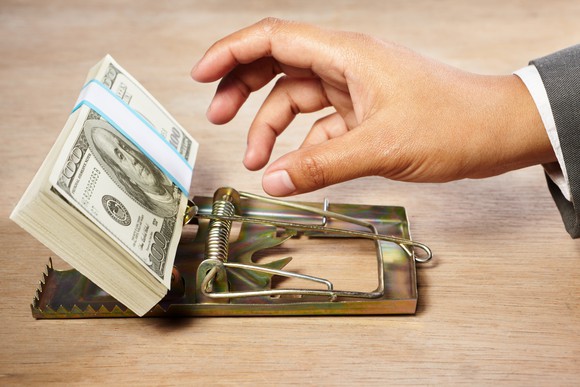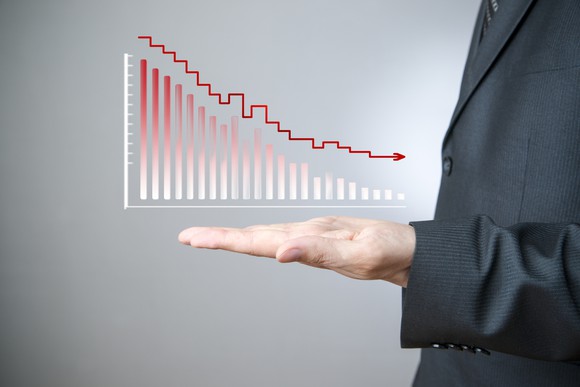Rite Aid Corporation (NYSE:RAD) stock fell hard every time Walgreens Boots Alliance(NASDAQ:WBA) lowered its offer for the struggling pharmacy chain's retail outlets. Now that the deal is cleared for takeoff, intrepid value investors are being drawn toward what looks like a clear-cut opportunity. Based on Walgreens' final per-store offering price, Rite Aid's stores are worth several times more than the stock's recent market cap.
Although the arithmetic works out in theory, an uncooperative Federal Trade Commission and a rapidly deteriorating outlook for retail in general both limit the pool of potential suitors for Rite Aid's remaining stores. Without a buyer, there are reasons to believe a slimmed-down version of the company might become profitable. Upon closer inspection, though, it looks like the worst is yet to come.

IMAGE SOURCE: GETTY IMAGES.
Why the phone isn't ringing
There's an argument that even if Rite Aid can't squeeze out a profit with its remaining operations, another retail pharmacy chain will eventually scoop up its remaining stores. After paying $4.375 billion for 1,932 stores, Walgreens will leave Rite Aid with 2,575 locations.
At the same price of around $2.26 million per store, Rite Aid's remaining locations should be able to fetch about $5.8 billion. It might look like Rite Aid's market cap is less than half the theoretical value of its stores. Unfortunately U.S. antitrust regulators have made it clear that future retail-pharmacy acquisitions will be an uphill battle.
If uncooperative regulators don't scare suitors away, the ongoing retail apocalypse might. Pharmacies have fared better than department stores, but a recent report from IHL Group shows that drugstore sales during the first seven months of the year declined 0.9% from the same period last year, and closures exceeded openings.
Earlier this month, rumors surfaced that Amazon.com (NASDAQ:AMZN) is in discussions with mid-market pharmacy benefit managers, and has been hiring consultants to test the waters for its possible entry into the drug retailing market. Many analysts think the retail behemoth will begin filling prescriptions within a couple years. Whether these rumors rapidly materialize or not, the whispers alone are another strong deterrent to any potential acquirer of Rite Aid's remaining operations.

IMAGE SOURCE: GETTY IMAGES.
A case of chronic decline
With little chance of another big asset sale, investors buying beaten-down Rite Aid stock need the company's remaining operations to become far more profitable. Unfortunately they've been trending in the opposite direction.
Rite Aid lost $21.1 million during the fiscal fourth quarter, and another $75.3 million during its fiscal first quarter this year. Although the company reported a $170.7 million profit during the most recent quarter, without the one-time $325 million merger termination fee from Walgreens, losses would have widened for the third straight quarter.
Pro forma metrics provided by management show the company will retain 2,575 stores that average $6.25 million in total sales, or about 8.7% more than the average store in its existing portfolio. A 10-year agreement that will allow the company to purchase generic drugs at lower prices, through a subsidiary of Walgreens, will help as well. Given the downward retail-sales trends reported by peers such as CVS Health (NYSE:CVS) and Fred's, though, a better mix of locations and the sourcing agreement probably won't be enough to return this company to sustainable profitability.
Failure to execute
Among Rite Aid's peers, CVS Health has been able to boost its bottom line at an impressive rate largely because it has successfully executed acquisitions of an enormous pharmacy benefits manager (PBM) in 2007, and long-term care operations in 2015. CVS reports intersegment revenue eliminations when PBM segment customers purchase their drugs at one of the company's pharmacies or long-term care centers. Intersegment revenue rose 7% in the first half of the year to $12.2 billion, which was a whopping 31.5% of total sales generated by the company's retail and long-term care operations.
Unlike CVS, Rite Aid doesn't operate long-term care centers it can supply with prescription drugs; the EnvisionRX PBM it scooped up a couple years ago is losing business and sending fewer customers into Rite Aid pharmacies. During the first half of Rite Aid's fiscal year, intersegment eliminations fell 9.6% lower than the previous-year period to just $81 million, which was a dismal 1.3% of retail pharmacy sales.
How Rite Aid won't spend a $4.38 billion windfall
Rite Aid's management intends to use nearly all proceeds from its purchase by Walgreens to reduce a crushing $7.1 billion debt load. While that should lower annual interest payments by more than $200 million, it's important to note the company won't be investing that money into operations that might improve its chance of survival.
Pharmacy benefit managers use their size to negotiate better prescription-drug prices for healthcare plan sponsors, but Rite Aid's PBM is small and getting smaller. Perhaps the company's new CEO can succeed where his predecessor failed. Without a steady stream of profits to invest, though, it's hard to see how this company will execute such a turnaround.
Say Goodbye to the Old iPhone: This Could Be 40X BetteriPhone mania is back, and there's potentially billions up for grabs. But if you think Apple is the best way to play the pending iPhone tsunami, think again. One tiny company holds the patents to an invaluable, tiny component inside Apple's newest iPhone -- and Apple has to pay up every time it puts this technology in its phones.
Don't wait until the name of this company is on everyone's lips.









